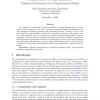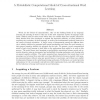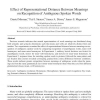COGSCI
2010
13 years 11 months ago
2010
We examine the verification of simple quantifiers in natural language from a computational model perspective. We refer to previous neuropsychological investigations of the same pr...
COGSCI
2010
13 years 11 months ago
2010
COGSCI
2010
13 years 11 months ago
2010
Words are the essence of communication: they are the building blocks of any language. Learning the meaning of words is thus one of the most important aspects of language acquisiti...
COGSCI
2010
13 years 11 months ago
2010
With human language, the same utterance can have different meanings in different contexts. Nevertheless, listeners almost invariably converge upon the correct intended meaning. Th...
COGSCI
2010
13 years 11 months ago
2010
This paper reports the results of a self-paced reading experiment in Japanese in which the materials consisted of four versions of successively more nested syntactic structures. I...
COGSCI
2010
13 years 11 months ago
2010
We created paired moral dilemmas with minimal contrasts in wording, a research strategy that has been advocated as a way to empirically establish principles operative in a domain-...
COGSCI
2010
13 years 11 months ago
2010
Previous research indicates that mental representations of word meanings are distributed along both semantic and syntactic dimensions such that nouns and verbs are relatively dist...
COGSCI
2010
13 years 11 months ago
2010
Computational models of meaning trained on naturally occurring text successfully model human performance on tasks involving simple similarity measures, but they characterize meani...
COGSCI
2010
13 years 11 months ago
2010
We used a new method to assess how people can infer unobserved causal structure from patterns of observed events. Participants were taught to draw causal graphs, and then shown a ...
COGSCI
2010
13 years 11 months ago
2010
With only two to five slots of visual working memory (VWM), humans are able to quickly solve complex visual problems to near optimal solutions. To explain the paradox between tigh...



